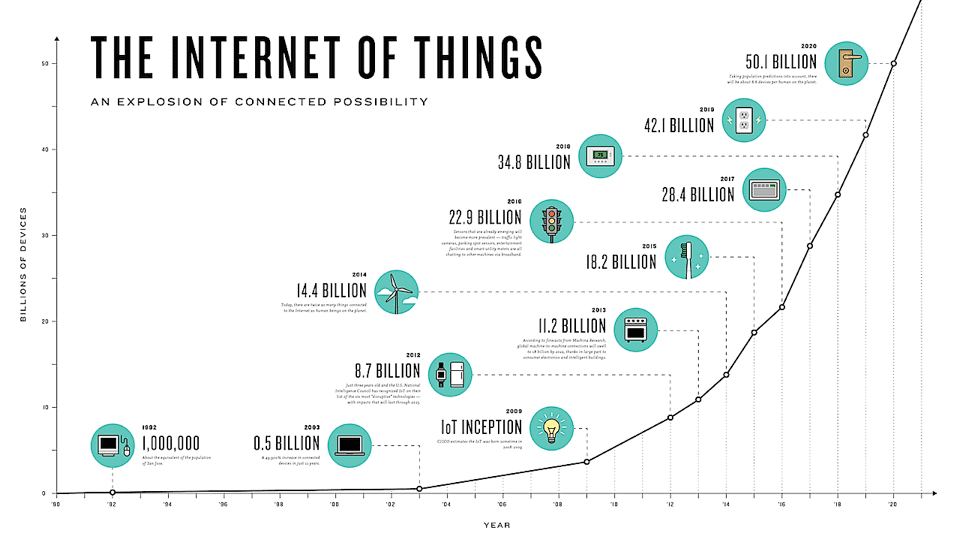Internet of Things (IoT); you have been hearing about this technology trend. With all the hype accompanying IoT, it’s easy to feel this is another “noise” related technology and not a “signal” that significant change is coming. Just wait a year or two and it will be gone.
OK, what is IoT, and is it significant? We are used to the Internet where humans interact with web pages and applications; much of our interactions have automated, computer -driven processes that drive desired outcomes. Say you use the Internet to order a pair of shoes for your college kid. Well, you navigate to the sites that sell shoes, select, complete the order and ship the shoes to your college student. Even though automated, computing systems that you did NOT interact with were involved (the credit card payment system, the warehouse pick ticket system), ultimately, your purchasing decision set these automated systems in motion. Well, welcome to Skynet, because the IoT is about machines, “things” triggering these processes and systems to act.
“Things” are sensors, thermostats, elevators, payment terminals that are now connected to the Internet. These “things” and their “connections” have the ability to sense their environment and trigger requests, issue alters, kick off processes and basically interact like you did when you purchased shoes for your student. You saw a photo of your child shoeless and this triggered a response to use the Internet to correct an issue you saw. Well, the thermostat in your vacation home just asked for the heat to come on, the thermostat realized the furnace did not respond, the temperature outside is cold enough for pipes to freeze so the thermostat triggers an alert to an HVAC company for emergency service. A human did NOT initiate this Internet process. So IoT is machines interacting with each other without human intervention.

Why is this significant? The costs of connected systems are falling by orders of magnitude, thanks to the combined effects of cheaper microprocessors, the flexibility and scalability of cloud storage and analytics, and cheaper wireless connectivity. New economics create new opportunity.
You may be thinking, “OK, that is a lot, but I really don’t care about IT spending. Because of the cloud, IT spending on hardware is drying up and moving toward devices and humans.” But you may be the one in the future making the IT decision. Another reason IoT is significant is the shift in technology decision-making for this spending, from traditional and centralized IT departments to decision-making within business units by line-of-business leaders. This shift is driven by the change in focus from back-office IT (servers and routers) to front-office IT (business applications and devices) (moving to the cloud). Gartner estimates that by 2019, more than three quarters of all new IT projects will be funded by individual business units directly responsible for generating growth. Let me state that again another way. I have been implementing business software for a long time. The closer the end users of an application are to the decision and implementation of a business application, the better the outcome of the implementation. More success, less failure, less risk. This is a HUGE benefit. A “the Donald” HUGE. So yes, that is significant.
So the benefits are that IT is getting less expensive (more success, less failure = less expensive) and the cost of connecting systems is getting less expensive. So we are able to get more IT for less, always good!
Want to learn more about the IoT? Contact KTL Solutions at 301.360.0001 or email us at [email url=”info@ktlsolutions.com” class=””]info@ktlsolutions.com[/email]!
References: De Clerck, J-P. “The Internet of Things Explained.” ISCOOP. I-SCOOP, 11 Dec. 2014. Web. 14 June 2016.
STEVE HAMMETT | Account Manager
Steve graduated from University of Maryland, Baltimore, with a Bachelor of Science (B.S.), in Economics and a few years later, a Master of Science (M.S.), in Information Technology. He has helped organizations for over fifteen years to solve business problems using technology. He is well informed with all Microsoft Business Solutions and is a Solutions Certified Sales Representative.Forfunhelooks to the outdoors, whether water, where he is a sailor (Coast Guard certified in Costal Piloting and Navigation), a PADI certified scuba diver, and a certified Red Cross Water Safety Instructor, or land, where he is a skier, hiker and mountain biker.




































